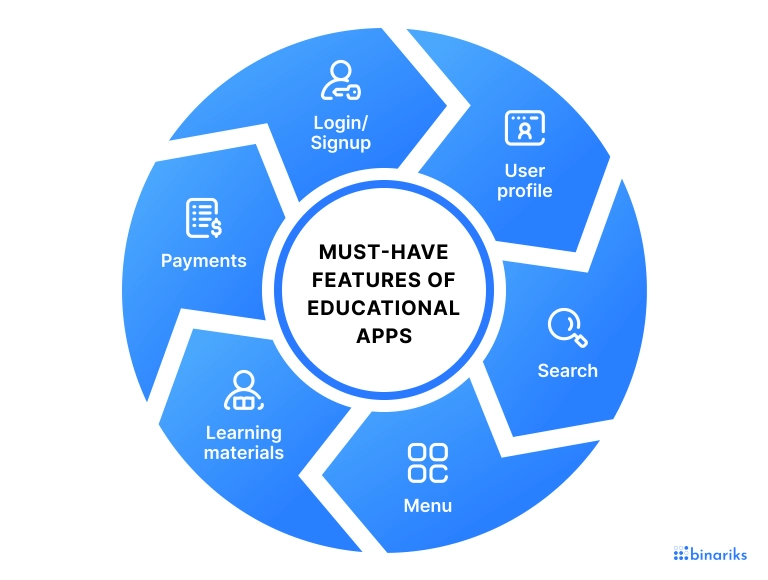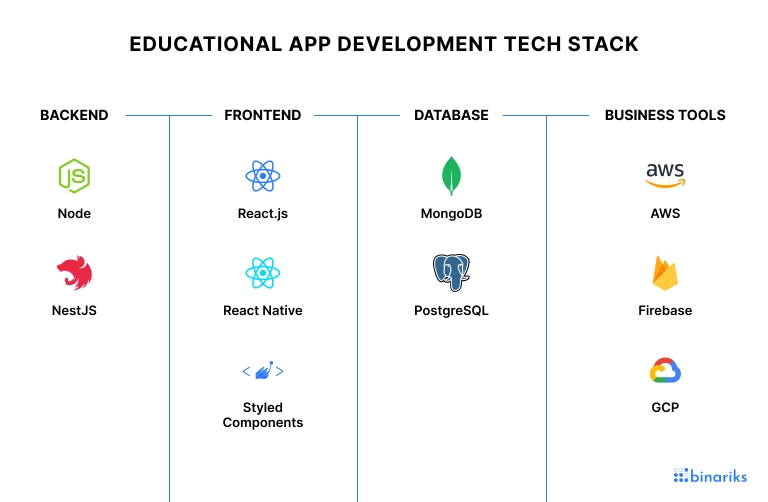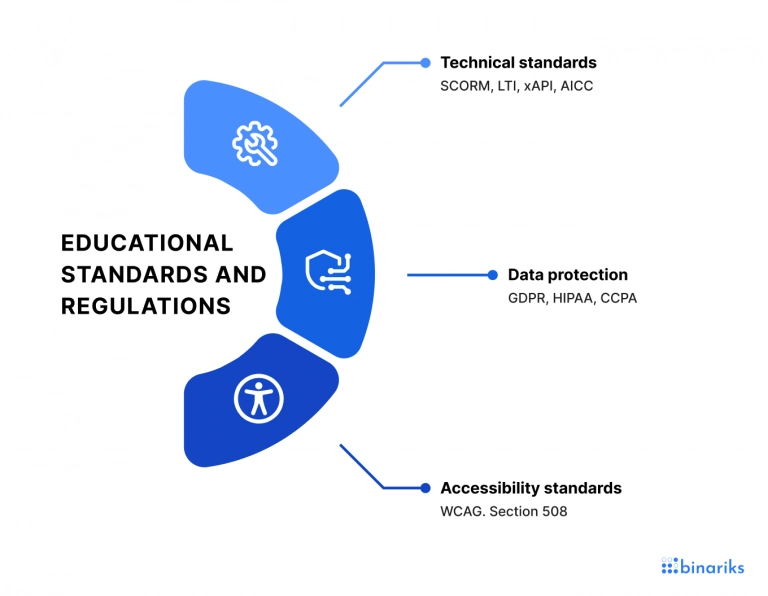Content
Show content
We are all experiencing dramatic growth in the mobile app development market: by 2030, it’s expected to reach a high mark of $366.34 billion, growing at a 23.80% CAGR. Up to 9% of users on both Apple Store and Google Play choose educational applications. What lesson can education leaders learn from this user behavior? First, people want to acquire the necessary skills and knowledge in a more interactive and convenient way. Second, it’s worth budgeting for e-learning app development initiatives to extend learning opportunities online. This and a couple of other trends are driving the demand for education app development .
You are now reading a guide that sheds light on crucial aspects of developing an educational app including market overview, benefits, development process, and most required features. Stay tuned and learn how to build an educational app!
The benefits of educational app development
The global e-learning market is expected to reach $457.8 billion by 2026 among the top educational app, developing countries the USA, Canada, Japan, China, Europe, France, German, Italy, and the UK. One of the major 290 companies in the ed app industry is Absorb Software, Adobe Systems, Aptara, Blackboard Cisco Systems, Cornerstone OnDemand, Coursera (that is the biggest educational platform), Skillshare, edX, Fischer, Hurix Systems Private.
The US is the world's largest education application development market and is estimated at $100 billion in 2022. When China, the world's second-biggest economy, is expected to have a market of $105.7 billion by 2026.
Companies build educational app to strengthen customer loyalty, market their products, gain new market shares, reduce costs, and improve material availability. What other benefits does online education app development bring? Let’s have a look at the most important benefits of educational mobile app development:
- You make your educational services more accessible and flexible. First of all, your materials can be accessed by learners all around the globe and allow them to progress at their own speed.
- You allow a more progressive and interactive learning process. Just like in DuoLingo, you can add some self-checking features, ask people to repeat the material, make micro tests, add toggle functions, and so on.
- You provide a personalized learning experience. Learners gain access to precisely the information they require.
- You enable real-time feedback and facilitate communication between educators and learners.
- You increase the engagement of learners. Think in the direction of notifications, reminders, progress tracking, task submissions, and many other useful features. As a result, you also decrease the number of drop-offs and raise the satisfaction rate.
Steps to make an educational app
I guess you wonder how to create an educational app. Before you begin, ponder upon some vital aspects such as who will be carrying out the development. If you have a tech team and expertise, you can develop an educational app in-house. And if you haven’t got neither expertise, or tech talents for education application development, you may consider hiring a tech partner like Binariks.
Follow the next important steps of education mobile app development process:
- Identify the target audience
You will have a different set of features depending on the end-users of your app. They can be individual or corporate learners, teachers, staff, coaches, or independent service providers.
- Define the app's features and functionalities
Think about the crucial functions you want to see in the first iteration.
To develop an educational app that serves your business right, make a list of business needs you want to resolve with the application. Then, consider what functionality and features will cover your needs.
Find a full list of features of educational software below in the “Must-have features of educational apps” chapter below.
- Choose the right platform
Have you chosen whether to build your app for Android or iOS? Or, maybe, you would prefer cross-platform development, which entails creating a single software that can operate on different platforms?
Choosing the correct platform for your app is critical in the online education business.
Currently, Google's Android has the most users - over 2 billion.
Although Android has more users than other platforms, more than half of the American smartphone market favors iOS as the operating system.
This implies you should consider developing your educational app for both iOS and Android.
You might also go with cross-platform mobile app development.
Before you pick an education application development platform, consider the end-user’s geolocation, the time required for education mobile app development, and app complexity.
If you are still unsure, you can engage an educational mobile app development partner. They will advise you on the appropriate platform for your app and create it according to your specifications.
- Design the user interface
Now that you know what type of application you’re making, take a look at applicable user interface best practices. For instance, an app for kids can require gamification and 3D elements. Meanwhile, an app for remote tuition may require a more simple and clean design with focus on structure.
At this stage, focus on making a list of features and milestones a user should encounter throughout the journey.
- Develop the app
Launch the app development. Ideally, you should divide your product development journey into sprints. This will allow you to fix issues and make retrospectives in a more cost-and-time-efficient way.
But what if you’re working with a tech partner? Then, the development process will look in the following way. First, you’ll have a product discovery phase where the tech team gathers product requirements. Then follows an active development phase subdivided into sprints. The collaboration finalizes with a product roll-out and maintenance.
Read how we ensure a secure software development lifecycle at Binariks to significantly reduce the cost of bug fixing and increase software security.
- Test and refine the app
Run automated and manual tests on your code. Invite users to test your product, gather feedback and work on the weak sides of the product.
Make security code testing a priority and introduce security best-practices on every stage of education application development.
- Launch and market the app
Show your product to the world and allow users to express their opinion about their experience of using your app.
It’s a common practice to ask people what features of educational software they find most useful and which ones should be dropped.
Deliver personalized learning experiences with top-notch apps Read more
Different types of educational apps
You may probably have an idea of a product in your mind and it could be helpful to take a look at a list of types of solutions before you launch education mobile app development process. We can roughly categorize educational apps into two parties: one for learners and another one – for teachers.
Educational apps for teachers
The market analysis shows multiple categories and features of educational software aimed at several target groups. Learning tools for teachers, adults, and kids require different solutions. The type of future app also depends on the field of study and learning approach. Generally, educational apps can be grouped into 6 categories:
- Remote tuition: These applications connect teachers with students to conduct the learning process remotely. Although remote tuition apps are top-rated among native speakers and language learners who want to master their speaking skills, they can be used for any other purpose.
The best remote tuition apps are:
- Preply
- Tutor.com
- YUP Tutor
- Wyzant
- Kahoot
- Skooli
- MyTutor
- Apps for kids: Heavily based on gamification and engagement, apps for kids enable parents to make their children's screen time more useful. DragonBox for maths lessons, YouTube Kids for educational and safe content, Spelling Stage for writing, and similar tools are usually designed to improve a specific child's skills.
- Language learning: Babbel and Duolingo are the two most renowned language apps among dozens of others. Such applications include interactive tasks in multiple foreign languages at several learning levels. They also have many gamification elements and can be used by kids and adults.
- Grading apps: Tests and regular checks are integral to the educational process. You may develop mobile solutions for corporate users and educational institutions to enable them to run check-ups more efficiently. Online tests are perfectly suitable for multiple-choice or short questions.
- Learning solutions for adults: Such services have more industry-specific tasks than apps for kids or language learning tools. This category includes deadline keepers, proofreading apps, citation apps, collaboration tools, and other solutions that can optimize learning.
- Classroom apps: They help teachers to create, distribute, manage, and grade assignments. They don't fully substitute classroom activities but make them more organized and easy to track. The primary target audience of classroom solutions is educational institutions that want to enhance the communication between teachers and students and/or launch remote learning.
Educational app types for learners
Based on most educational app user types, they may be broadly classified as learning solutions for students, instructors, and people who self-learn through online courses.
When creating educational applications, the focus is nearly always on the students. On the other hand, expert instructional designers recognize that a specialized app is also required for their teaching and assessment tasks. These applications give them the resources they need for seamlessly manage, prepare, and store the student learning aids.
- Storing teaching material: One of the key benefits educational app development has given to theeducators is the ability to use a one-stop-dhop storage destination for all instructional content, divided into discrete compartments for easy access whenever needed.
- Planning and scheduling apps: Planning and scheduling applications simply make their life easier by allowing them to save forthcoming events and activities in a way that allows them to be reminded of them far in advance.
- Evaluating student progress: Grading apps are an excellent example of educational applications that make life easier. Whereas the average teacher spends most time verifying and analyzing assignments, grading applications automate the process, saving time and allowing teachers to schedule new activities.
- Assessing performance: Students can sign up for these and utilize them as required for solo or group learning. Applications may be created to help students analyze their progress across subjects. The applications can also be complemented with an LMS (learning management system), which allows students to participate in various examinations or assignments based on their understanding of the subject.
Read how we developed an e-learning platform for data validation. Read more Development of Education Platform
Must-have features of educational apps
Even though the functionality will vary depending on the type of educational application, some features are present in most online education app development solutions. Pay attention to them while planning your next product.

- Login/Signup: Limit access to educational apps to protect personal information, including learning progress, contact info, payment details, etc. Also, think about adding an opportunity for educators to invite students to classes via a uniquely generated link. This will ensure additional security and ease-of-use for teachers.
- User profile: Enable users to view all the completed courses, access tasks, and track their learning achievements from a separate profile. Keep in mind that while completing homework, people need to upload various types of files such as text documents, links, videos, and audio files so add a feature for that. Additionally, allow people to access the course materials after finalizing the course.
- Search: Help users quickly find the necessary content by filters such as name, subject, duration, etc. This feature will reduce the teacher’s workload and annul the user’s confusion.
- Menu: Simplify in-app navigation allowing users to access a specific app section in just a few clicks. When necessary, engage user experience designers to deliver the best possible experience for learners.
- Learning materials: Add courses, games, exercises, and/or tests as applicable. Allow learners to pass tests and go through their journey in their own pace.
- Monetization: Think about the most suitable way to profit from the deployed solution (that's why you create it in the end). For instance, you can implement ads, in-app purchases, white labeling, or paid subscriptions.
- Payments: Take care of secure payment functionality if your app supports financial transactions. Consider adding an opportunity to automatically charge learners on regular basis. And, if necessary, add an ability to pay the price part-by-part.
Besides the features mentioned, many educational applications include statistics dashboards, push notifications, scheduling, social sharing, and cross-platform support features. Before initiating the development process, make sure to determine what core features you want to have in the app.
Additional features of educational apps
But that’s not all. There are the following additional features of educational software.
- Scheduling: Offer live streams of lectures or real-time communication with teachers and other students. It can still win the favor of users who prefer organizing their self-paced studying.
- Push notifications: Push notifications are even more valuable: missing a lesson as an instructor can be a huge blow to one’s reputation.
- Statistics and analytics: Identifying blind spots in knowledge helps adjust the program and eliminate issues.
- Social sharing: Implementing one-click sharing enhances your app’s chances of gaining new users among your existing users’ friends.
- Cloud integration: Schools might provide their own devices, and app users can have them. It’s important that progress is synced via the cloud and app can be opened on as many devices as possible.
Educational app development tech stack
For custom learning solutions, educational app development companies recommend Kotlin (for Android native apps), Swift (for iOS native apps), Java, Node.js, React, and Blockchain (for backend development).

Backend | Node, Nest,js |
Frontend | React,js, React Native, Styled Components |
Database | MongoDB, PostgreSQL |
Business Tools | AWS, Firebase, GCP |
UI/UX Design for your educational app
With high competition in the educational mobile app development industry, you'll need to catch and keep your consumers' attention if you want to succeed. Aside from providing great learning, the best practice to accomplish this is through the assistance of a UI/UX design.
- Draw attention: The possibilities are endless when it comes to UI – color scheme, aesthetics, and so on. You may make your app colorful and cartoonish, load it with superb photographs and videos, or make it as simple as possible, depending on your target demographic and the topics it will cover.
- Engage users with well-planned learning activities: In language learning applications, for example, new words frequently merge with audio/video samples, changing into "fill in the gaps" and quiz-type problems; some tasks are timed, while others are not. A team of designers collaborates with curriculum authors to determine the best moment to swap tasks so that learners remember new material and don't grow bored.
- Retain users: We never get tired of saying it: any software, especially an instructional tool, must be intuitively comprehended. The sequence of displays, the placement of buttons, and the frequency and size of pop-up alerts (to rating the app) must all be carefully planned.
- Be up-to-date: Consider current design trends, as well as the applications that your target audience utilizes (learning apps and other types of apps). It will enable you to design and develop an educational app that consumers will not want to quit.
Integration for education applications
If you feel like there aren’t enough features of educational software, you can always address some notable education app integrations that are widely utilized in the educational area. Here are a few examples:
- Learning Management System (LMS) integrations: Canvas, Blackboard, and Moodle are prominent LMS platforms that are used in online education app development. These solutions simplify the learning process by allowing teachers to control course content, monitor student progress, and offer feedback.
- Video conferencing integrations: Zoom, Google Meet, and Microsoft Teams, have become indispensable for creating educational apps. These solutions enable professors to work in live classrooms, track virtual office hours, and have a real-time collaboration with students.
- Assessment integrations: Assessment applications such as Kahoot!, Quizlet, and Quizizz are frequently used to produce interactive quizzes and assessments. These interfaces enable teachers to integrate questions from these applications into their LMS systems.
- Learning content integrations: Learning content applications such as Khan Academy, Duolingo, and Coursera give students access to high-quality learning resources. These solutions enable teachers to assign students particular content, allowing them to customise the learning experience.
- Classroom management integrations: Classroom management apps such as ClassDojo, Seesaw, and Edmodo are popular for communicating with parents and guardians, sharing classroom updates, and tracking student conduct. These integrations keep parents informed and engaged in their child's education.
Educational standards and regulations
Education mobile app development standards are guidelines for material, writing software, and learning management systems (LMSs). They establish rules for all stakeholders to create and generate content, deliver it across platforms, and ensure device compatibility.
E-learning standards are classified into three groups. Courseware design standards include many course design and development areas, whereas technical standards cover course implementation on an LMS or other portal.

Technical standards
- SCORM
- LTI
- xAPI
- AICC
Data protection
- GDPR
- HIPAA
- CCPA
Accessibility standards
- WCAG
- Section 508
Considerations in creating an educational app
Before you get down to learning management software development, make sure to run a market analysis. To help you with your research, we've collected the main trends in edutech.
Focus on certification and professional content
Users prefer to be sure that after finishing courses, they will have proof of completion. The most renowned digital learning resources provide certificates, including Lynda LinkedIn Training, Oxford Home Study, and Google Digital Garage. Therefore, if you want to develop an educational app that looks reputable, manage to issue valid certifications. Educational apps for kids may be the only exception. It's also recommended to engage professional educators and industry experts to develop the training package tailored to the target audience's needs.
Abundance of videos and micro-training
Flexibility and optimization of the learning process is why students opt for educational apps. Thus, in developing your next solution, you should favor short informative videos over long texts. Or combine videos and texts. Besides, splitting the program into multiple smaller lessons followed by tests is important. Such an approach is the most effective and convenient way to teach something remotely.
Gamification, VR, and AR in educational technology
80% of US employees believe game-based learning methods are more engaging. 50% have managed to improve their productivity thanks to gamification training features. Virtual and augmented reality have also become more widely used in online learning solutions. They can make your app stand out in the crowded market and attract tech-savvy users.
Intuitive UX/UI and ease of use
A quality interface and smooth navigation are critical to creating an app that encourages users to proceed with the next learning level. The assistance of a UX/UI specialist should help you improve the user experience.
Educational app development cost
We understand that you want to know the final amount before starting educational app development. Unfortunately, the duration and scope of the engineering process depend on too many variables to tell this without details.
The average cost of build an educational app is between $5,000 and $20,000. Basic elements such as flashcards, quizzes, and interactive games may be included in this sort of software.
Developing an educational app with more comprehensive features such as individualized learning routes, artificial intelligence, or augmented reality might cost $50,000 or more.
When an education app development company estimates an approximate cost of engineering services, they rely on the following factors:
- Engineering team size and experience of tech specialists
- Local market hourly rates (In Eastern Europe and Asia, you can get the same quality at a more affordable cost)
- Technical specifications of the app, number of apps (in case you need both iOS and Android versions, the development cost will be higher)
Development team for your educational app
Building a custom elearning app tailored to the needs of teachers, students, corporate employees, or people interested in self-education requires solid technical expertise. The team size and structure directly impact the cost of education application development. Mind that gathering a team of educational app developers is a resource-consuming process that entails engagement of managers from the HR, IT, and financial departments. Delegating educational mobile app development to a tech partner is one of the most cost and-time-effective practices so far.
When you build an educational app for iOS and Android, you need a development team. Here are the specialists you'll need to build your project:
- Business Analyst
- Android developers
- UI/UX designer
- iOS developers
- Project Manager
- QA engineer
- Back-end developers
- Front-end developers
Hiring an in-house team or an outsourced business are the two major approaches to collaborate with IT professionals. Both solutions have advantages and disadvantages. It is simpler to connect with in-house teams, but they are more expensive owing to office rent, equipment (hardware and software), and other costs. On the other hand, developers from outsourcing companies provide competitive rates and good product quality.
Binariks experience in educational app development
Developing an educational app is the same as any typical mobile software creation cycle. First, you will need to develop an educational app ideas and dive into market research to understand whether they are relevant and profitable. If you find out that the future solution has a strong chance to succeed, it's time to talk with professional education app developers.
In word and deed, about one of our educational app case studies . Our client provides education-related software to a broad category of users. The customer decided to launch an application that issues and verifies educational badges. The platform aims to validate its users' academic records, improving their employment opportunities and perspectives to ensure maximum security.
Binariks provided a dedicated team composed of solution architect, backend developer, frontend developer, UI/UX designer, QA, and a project manager. On the customer side, there was only a product manager. Our specialists developed architecture for the client’s web platform and MVP with Java backend and React frontend.
You can fully cover these stages with your in-house engineering resources (if you have any) or educational software development services . In particular, Binariks offers several team models to take up projects at initial or later stages. We can assemble a dedicated team of business analysts, UX/UI experts, developers, and QA specialists in designing a learning solution from scratch or providing team extensions to power an existing staff .
Conclusion
If you want to find out the educational app development cost for your project, contact us for a talk. Our tech specialists will evaluate your idea and offer the optimum way to realize it. Binariks works with a broad range of technology and has already completed educational projects for customers across the globe. Yours can be the next.
FAQ
Share
Related articles
EHR Certification: Understanding Requirements and Process
Oct 6, 2022 · 11 min read · Liliya KostetskaHow to Integrate an EHR system like Epic, Cerner or MEDITECH
Jun 16, 2023 · 12 min read · Ross Chornyy

